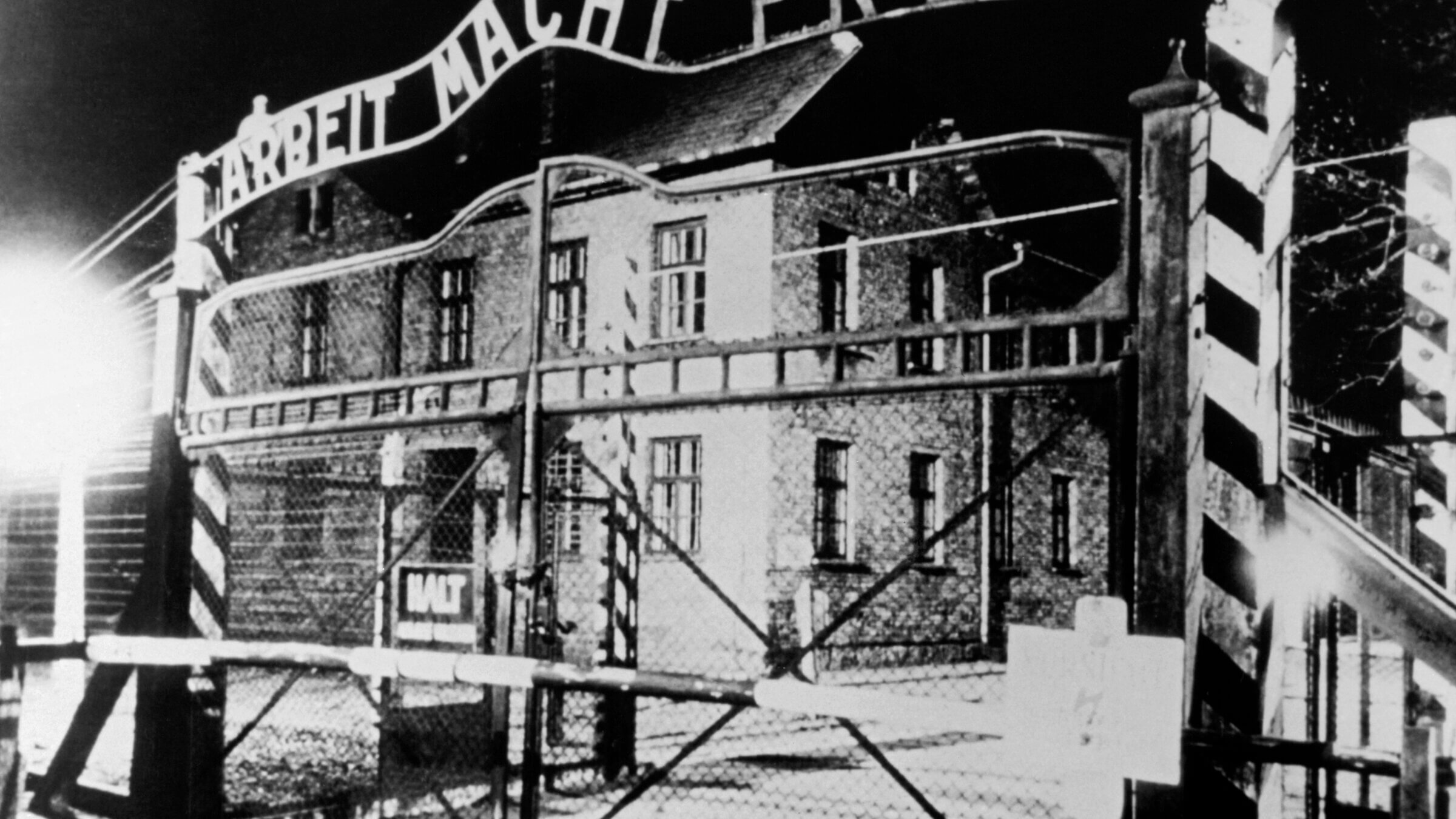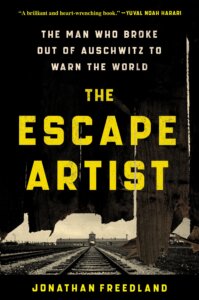They fled the hell of Auschwitz, but that was not the only catastrophe they faced
Jonathan Freedland’s ‘The Escape Artist’ recounts an unforgettable story of Holocaust survival

Auschwitz, as seen in January, 1945. Photo by Getty Images
The Escape Artist: The Man Who Broke Out of Auschwitz to Warn the World
By Jonathan Freedland
Harper, 400 pages, $28.99
Only four Jews, out of the millions who were transported to the Nazi killing camp at Oświęcim in Occupied Poland, managed to escape. Jonathan Freedland’s “The Escape Artist” aims to tell the now relatively unknown story of how, in April 1944 — after around 1.75 million Jews had been slaughtered in front of their eyes — Walter Rosenberg and Alfred Wetzler were the first to escape.
Their story has been told several times over the years — by them and others. The reasons that it has been repeatedly ignored and forgotten are among those prompting Freedland to tell it again. Freedland recounts Rosenberg’s experiences and his dawning recognition of what the Nazis were doing and how it depended on obscuring the truth.
“As he worked,” Freedland writes, “he only became more convinced that he had understood the Nazis correctly. A smooth process of destruction was what the SS wanted and, for that, absolute, watertight ignorance was a prerequisite.”
Rosenberg didn’t just escape to save himself — in order to defy the Nazis and save lives, he wanted to bring truth to the world.
“It was clear to him,” Freedland writes, “that the Jews destined for destruction could defy their fate here only if they knew of it … Somehow Walter had to get out of this place and tell the world what was happening.”
The weight of the truth, however, was not sufficient to pierce the “bubble of ignorance in which the Nazis sought to envelope their victims.” It needed the intercession of the flamboyant diplomat George Mantello and the English reporter Walter Garrett to get the message to audiences that could make a difference. They were, on the face of it, crucial because of their position as what might now be called “influencers.”
And, even then, the truth was not enough.

The Hungarian Jewish community could not bring themselves to usefully process the detailed information in the report that had been specifically brought to save them. As for the Allies, Freedland notes, they had no interest in disrupting their war efforts by trying to put Auschwitz out of commission. A distrust of the intelligence and the lack of political will on the part of the Allies to help “wailing Jews” meant they did little or nothing, no matter how much they learned (as early as 1942) about Auschwitz and the other death camps.
Even those who were predisposed to help found it difficult to comprehend: “I knew, but I didn’t believe it. And because I didn’t believe it, I didn’t know,” the French-Jewish philosopher Raymond Aron said. So, despite the fact that hundreds of thousands of Hungarian Jews were saved for a variety of reasons, including his report, Rosenberg remained bitter for the rest of his life. He blamed the Jewish leaderships of Hungary and Slovakia for betraying their communities and carried that blame over to various Israeli leaders after the war.
Since Freedland and I were both members of English Habonim Dror (a Jewish socialist Zionist youth movement) in the 1980s, certain challenges have barely changed. One glaring example of these is how to explain the Holocaust to an audience that knows little or nothing about it, while at the same time adding something impactful to the corpus of Shoah literature for those who already live with the knowledge of the Nazis’ systematic mass murder of the Jews of Europe.
Indeed, in a strictly pedagogical sense, that split mandate was essentially the challenge that the young Slovakians Rosenberg and Wetzler faced when they escaped the Nazi killing camp. They needed to “warn the world” — and specifically the half million Hungarian Jews who were yet to be transported to Auschwitz at the time of their escape. But the scale and brutality of the Nazis’ continent-wide dehumanization and murder project was almost impossible to convey. The people in the camps lived every day intimately acquainted with the obscenities of Nazi rule; people beyond the camps knew too little to care.
How could Rosenberg and Wetzler even think they could tell the Allies and the remaining Jewish communities enough to make a difference?
As clerks of the camp, the two had “a measure of free movement” and might even have survived to the end of the war. However, as clerks they also had “increased proximity to information” which, along with their exceptional longevity, meant that they could testify accurately to about 1.75 million murders. They decided to go when the Theresienstadt Czech community was slaughtered after a 6-month stay of execution in the camp. If the Nazis were killing the “model” Jews they had kept to show the Red Cross, they would kill every Jew in Europe. Wetzler and Rosenberg had been in Auschwitz for about two years each; the average survival time of a prisoner in Auschwitz was barely three weeks.
To avoid detection by the Nazis, Rosenberg took the identity and name of an Aryan Czech — Rudolf Vrba. That name, washed clean of any Germanic taint, would be the one he kept for the rest of his life. He used the name for both his report and his later memoir “I Cannot Forgive” (later re-released as “I Escaped from Auschwitz: The Shocking True Story of the World War II Hero Who Escaped the Nazis and Helped Save Over 200,000 Jews”), as well as for his repeated testimonies over the decades.
At the heart of the book is Vrba’s biography, centered on his Auschwitz experience, but Freedland does not stop with the escape. He pauses to consider the fate of the Vrba-Wetzler Report that the escapees produced immediately on their arrival at a safe house of the Resistance, outlining in detail the atrocities committed at a single one of the German death camps in Poland. The report did not immediately succeed; indeed, it arguably did not succeed at all.

There are two minor weaknesses in Freedland’s otherwise compelling and vivid account. First, Freedland skates over Vrba’s falling out with Wetzler. Given the intimate relationship of their camp existence, escape and tour to spur the Jews and Allies to action, their subsequent estrangement feels abrupt and calls out for a more detailed explanation.
Then, provocatively, Freedland calls the apparent suicide of Vrba’s older daughter “the greatest catastrophe of his life” — even greater than his immolation in the hell of Auschwitz for over 20 months. According to Freedland, Vrba felt that he had been guilty of both transmitting the idea of suicide and of not spotting its possibility and averting it. He learned there had been a history of suicide in his family, and he framed his daughter’s death as a form of second generation survivor trauma.
For Vrba, whose greatest achievement was a carefully planned, and excruciatingly executed escape it is devastating to know that there is no escaping history. Freedland starts by recounting how Vrba and Wetzler get past the guards and the fences. They need to do it alone and without telling anyone else anything, because prisoners and locals will be murdered for any help they provide. The two-stage escape involves the pair planning to almost starve in the no-man’s land between the inner and outer fences with “cheap, Russian tobacco… soaked in petrol and dried” to disguise their smell from the guard dogs. With no outside contacts and no way of knowing who to trust, the journey to true freedom stretched for miles and weeks beyond the borders of the camp. Indeed the book could be considered an ongoing account of Vrba’s continuing journey.
In Freedland’s telling, Vrba emerges as a preternaturally sharp man whose punctiliousness in the face of an infernal abyss and scrupulous escape is one of last century’s great achievements. He went on to have a career as a biochemist in the UK and Canada, but he was always more famous as a Holocaust witness. His confident, accurate, detailed demeanor meant he was called to testify in war crimes trials across the world and to appear in Holocaust documentaries, most notably in Claude Lanzmann’s “Shoah.”
As Freedland follows Vrba’s descent into hell and his epic journey from the abyss to deliver the truth, he takes no shortcuts, leading us through the most harrowing era of modern human history and the traumatic disappointments that follow it. With painstaking detail, he uncovers the humanity in one of the Shoah’s great witnesses but also brings Vrba’s truth about Nazi inhumanity to a new audience in a riveting, accessible way. It’s a weighty but sharp tale that should become one of the most stunning texts on required high school reading lists of the future.




















